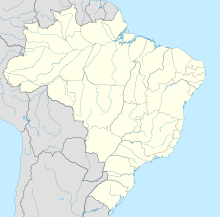Pitinga mine
| Location | |
|---|---|
| Location | Presidente Figueiredo |
| State | Amazonas |
| Country | Brazil |
| Coordinates | 0°45′12.5″S 60°06′05″W / 0.753472°S 60.10139°WCoordinates: 0°45′12.5″S 60°06′05″W / 0.753472°S 60.10139°W |
| Production | |
| Products | Tin |
| Owner | |
| Company | Minsur |
The Pitinga mine is a open pit tin mine in Brazil. It is thought to have the largest undeveloped tin deposit in the world. A complete community of 5,000 people was established in the remote location in the Amazon rainforest to support the mining operations, which began in 1982. There have been accidents, but efforts have been made to minimise environmental damage and to restore areas that have been mined. As of 2014 the more accessible alluvial deposits had been exhausted, but mining of primary rock was continuing.
In the 1970s the Amazon Radar Project detected deposits of cassiterite (tin ore) on the Waimiri Atroari Indigenous Reservation. Prospectors of Mineração Taboca, a subsidiary of the Paranapanema heavy civil construction company, found traces of cassiterite in 1979 in tributaries of the Pitinga River. The ore was reported to assay 2.1 kg/m3, much higher than typical deposits in Rondônia to the north. Paranapanema, assisted by Funai and the National Department of Mineral Production, managed to have the reservation downgraded in 1981 to the Temporary Restricted Area for the Attraction and Pacification of the Waimiri Atroari Indians, with a reduced area that excluded the cassiterite deposits. Presidential decree 86.630 of 23 November 1981 removed 526,800 hectares (1,302,000 acres) from the reserve for the tin mining operations.
In 1982 the US Bureau of Mines estimated that Brazil had total reserves of 67,000 tonnes of contained tin. In 1986 the Pitinga reserves alone were estimated at 575,000 tonnes of contained tin. The Mineração Taboca concession covers 130,000 hectares (320,000 acres) in 14 lots, but as of 1992 only 7,200 hectares (18,000 acres) were being actively exploited. Primary deposits are found in the hills of the Serra da Madeira and alluvium deposits have been washed down into the forested valleys. The alluvial deposits, now exhausted, consisted of greisens associated with the Água Boa biotite granite and the Madeira niobium-tantalum-tin deposit. The coarse-grained porphyritic albite granite has intruding paleoproterozoic acid volcanic and pyroclastic rocks. It includes Rapakivi granite and Biotite granite.
...
Wikipedia

